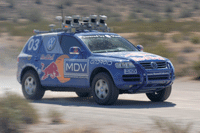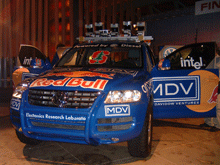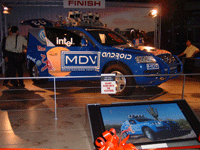Pretty soon, you won’t need a driver’s license to get your own set of wheels. Not if you can afford the Volkswagen Stanley, hands-down the smartest land vehicle man has ever built. This is no science fiction, as Stanley, the 3-year-old brainchild of Volkswagen that doesn’t require a driver is on a world tour of Asia, America, Africa, and Europe, with Singapore being its only Asian stopover.
 The only model in the world is not for sale and is currently housed at the Singapore Science Centre, where the 4-wheel drive was launched in Asia on Jun 28, left seasoned motoring enthusiasts standing in awe before it. From the first look, it gives the impression of any other mid-sized luxury SUV since Stanley is derived from the Touareg prototype. But take a peek into its luggage compartment at the rear end and you will see the highly sophisticated environment of Stanley’s brain. For passengers, the 5 comfy leather seats in the front for travel.
The only model in the world is not for sale and is currently housed at the Singapore Science Centre, where the 4-wheel drive was launched in Asia on Jun 28, left seasoned motoring enthusiasts standing in awe before it. From the first look, it gives the impression of any other mid-sized luxury SUV since Stanley is derived from the Touareg prototype. But take a peek into its luggage compartment at the rear end and you will see the highly sophisticated environment of Stanley’s brain. For passengers, the 5 comfy leather seats in the front for travel.
What does it do for brains? Well, according to the Singapore Science Centre, Stanley has 100,000 different software developed by Stanford University running through its 7 interconnected Intel Pentium M 1.6 GHz processors and Intel motherboards, all operating on a Linux operating system. From steering to deceleration, every single decision and maneuver is executed by this cluster of computers that work in perfect synchronisation. To receive information about the external terrain, Stanley has on its roof rack 5 LIDAR units, highly developed 24-GHz radar equipment, a Monocular Vision Camera, 2 satellite-supported GPS navigation system, and an Inertial Measurement Unit that consists of gyroscopes and accelerometers to measure rotation and movement of the vehicle. What a mouthful.
 The equipment monitors its surroundings constantly and sends electrical signals to Stanley’s respective ‘limbs’ such as the wheels, brakes, and accelerator. Speaking about these ‘limbs’, they physically move when in use, just like those pianos that seem to play themselves, even there’s no one in the driver’s seat. But shifting a gear isn’t as easy as it is for humans. Stanley has to relax on the accelerator, step on the brakes if needed, and with its robotic arm already connected to the console, move the gear lever in smooth synchronicity.
The equipment monitors its surroundings constantly and sends electrical signals to Stanley’s respective ‘limbs’ such as the wheels, brakes, and accelerator. Speaking about these ‘limbs’, they physically move when in use, just like those pianos that seem to play themselves, even there’s no one in the driver’s seat. But shifting a gear isn’t as easy as it is for humans. Stanley has to relax on the accelerator, step on the brakes if needed, and with its robotic arm already connected to the console, move the gear lever in smooth synchronicity.
The state-of-the-art software and equipment installed have been road-tested when Stanley took part in the 2005 DARPA Grand Challenge in the USA and, to immense excitement, emerged champion. The Challenge involving 23 other state-of-the-art cars similar to Stanley was held in the treacherous settings of the Mojave Desert with a time limit of 10 hrs to complete the 282-km course. Stanley crossed the finish line first with a record of 6 hrs and 54 min, and that shows that it is capable of avoiding obstacles and negotiating turns at military speeds!
The competition route wasn’t revealed until the start of the race. Bear in mind that without any humans on board, Stanley had to rely on his own processing power to negotiate turns, avoid obstacles, ‘feel’ the ground, follow the challenge route, regulating speeds, the list goes on. Basically, there was no programmed maneuver and Stanley had to literally think as he moved.
One of the highlights featured at the launch was Stanley’s environmentally friendly engine. Out of the 23 contestants in the Grand Challenge, Stanley was the only one that uses SunFuel, a renewable energy. This synthetic fuel is derived from biomass and produces extremely low emissions. This technology is certainly a yardstick of environment protection for all transportation of the future.
Technology found in Stanley will be put to use in the drivers’ market through innovative driver assistance systems to make driving safer. For examples, using radar measurements, a car can pull on the brakes automatically if the driver fails to stop within a certain distance from a pedestrian in his course. If the car gets too close to the road kerb, the steering wheel can provide steering impulses which cause the driver to take the necessary actions intuitively.
Stanley will not disappear anytime soon too because the main goal of the Stanley prototype is to serve militaries around the world as smart vehicles. It will replace soldiers in high-risk missions to save more lives on battlefields.
The current collaboration between Volkswagen and Stanford University will see more research conducted to increase the car’s capabilities. Stanley is slated next to be able to travel autonomously in an urban setting, where it will have to cope with pedestrians, lousy drivers, traffic lights, and occasionally dogs that run across the roads. These are exciting times and in the future, this technological masterpiece might be the root cause of why there are fewer road accidents.
Catch Stanley at the i-Space Theatre from Jun 28 to Aug 12.
Tel:64252500 Fax: 65659533 Website: www.science.edu.sg
Open daily from 10am to 6pm Closed on Mon except on school & public holidays
Admission Charges $6.00 Child (3-16 yrs): $3.00 Senior Citizen: $3.60

